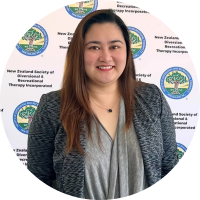The Power of Diversional and Recreational Therapy:
Purposeful Engagement with NZSDRT
About our guests:


Lorraine Bailio
Alongside her leadership role with NZSDRT, Lorraine works as the Lead Diversional & Recreational Therapist at St. Andrew’s Village. She is passionate about creating environments where people feel valued, connected, and empowered, focusing on meaningful activities that foster community, purpose, and joy.
Lorraine champions professional growth and innovation within Diversional and Recreational Therapy, continually seeking new ways to enhance wellbeing and engagement across care settings.
AJ Aledron
Originally from the Philippines, AJ is a passionate advocate for continuous professional development and high-quality practice in Diversional and Recreational Therapy.
He is the Programme Leader for the Certificate in Diversional Therapy & Community Health at Kauri Academy and Director & Master Coach at Brain Champ NZ, specialising in therapeutic recreation and cognitive mastery.
AJ is driven by collaboration and guided by the belief that “With your basket and my basket, the people will thrive.”
How do we move beyond “activities” and use everyday engagement to change health outcomes? NZSDRT’s Lorraine (St Andrew’s Village) and AJ (Kauri Academy/BrainChamp NZ) share a practical, person centred approach that restores identity, connection and joy across aged care, disability, mental health and community services. Grounded in the APIED process and Te Whare Tapa Whā, they show how to turn life stories into therapeutic roles, calm distress, lift mobility and confidence, and evidence results for audits and continuous improvement.
Key takeaways:
- See the person, not the diagnosis: DRT focuses on identity, purpose and connection—not just “keeping people busy.”
- Use the right frameworks:
- APIED: Assessment → Planning → Implementation → Evaluation → Documentation.
- Te Whare Tapa Whā: balance physical, mental/emotional, family/social and spiritual wellbeing.
- Start with the life story: link every plan to a resident’s background—former tailor teaches sewing and walks unaided; retired manager leads table checks and regains confidence.
- Purpose over pastime: activities must have meaning; purpose is the strongest motivator for movement, engagement and recovery.
- Therapeutic tools that work:
- Movement: chair yoga, tai chi, walking with intent.
- Creative: art, craft and reminiscence for self-expression.
- Music: calms emotions, lifts mood, reduces stress behaviours.
- Everyday roles: gardening, mentoring, or welcoming new residents.
- Inclusion as therapy: safe, non-judgemental spaces support identity and culture; belonging itself improves wellbeing.
- Measure what matters: improved engagement, mobility, confidence, mood, and audit outcomes are all indicators of success.
- Evidence your impact (MIA method):
- Minutes: record handovers, attendance and resident feedback.
- In-service: share results across teams for learning.
- Audits: internal reviews drive continuous improvement.
- Document to demonstrate quality: record goals, plans and progress in your care system (e.g., VCare) and use reports to show participation and outcomes.
- Partner across disciplines: nurses, HCAs, kitchen staff, and whānau all contribute to wellbeing—collaboration builds stronger results.
- Invest in growth: NZSDRT membership provides professional development, networking, and recognition as allied-health professionals.
- Start today: ask one more life-story question, create one purposeful role, and record one measurable outcome.
